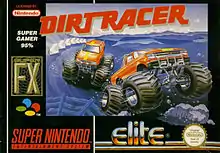Dirt Racer
Dirt Racer is a Europe-exclusive video game for the Super Nintendo Entertainment System developed by British studio MotiveTime and released in 1995. This game uses the Super FX powered GSU-1 to provide enhanced graphics.[2]
| Dirt Racer | |
|---|---|
 Cover art | |
| Developer(s) | MotiveTime, Ltd.[1] |
| Publisher(s) | Elite Systems Ltd.[1] |
| Platform(s) | Super NES |
| Release | |
| Genre(s) | Offroad/rally driving[1] |
| Mode(s) | Single-player |
Gameplay
Players must drive their dirt track racing vehicle across a road rally. The car comes complete with a speedometer (in kilometres), a lap counter, and a lap time counter. There are a pre-determined number of chances to complete the game, like in Super Mario Kart and F-Zero. If the player is unable to defeat the game in those number of tries, then the player gets an automatic game over. A yellow smiley face shows up to track the performance of the driver.[3] If it's smiling, then the player is winning. Otherwise, the player is losing the game.
Development
Dirt Racer was developed by British studio MotiveTime. It was the second racing game using Super FX technology simultaneously developed under publisher Elite Systems, the other being the unreleased PowerSlide.[4][5][6][7][8][9] Dirt Racer programmer Chris Nash and graphic artist Adam Batham stated that development began in September 1993 after they dissected and analyzed the cartridge for Star Fox. They claimed that the updated iteration of the Super FX allowed them to utilize twice as many polygons as in Star Fox.[10] Unlike the racing game Stunt Race FX, Dirt Racer did not allow to change the viewing perspective because the designers saw it as a needless waste of memory.[11] Elite Systems development manager Trevor Williams explained that the game's race courses were generated on a "square mesh" which could be raised or lowered to create variable terrain.[4] The game's computer AI-controlled opponents were programmed to dynamically adjust to the skill level of the player so that even beginners stand a chance of winning.[11]
Reception
Dirt Racer received largely negative reviews from print publications during its release including 51% from Super Play,[12] 30% from Total!,[13] and 21% from GamesMaster.[14]
References
- "Release information". GameFAQs. Retrieved 2011-05-20.
- "Super FX chip information". SNES Central. Retrieved 2011-05-24.
- "Advanced overview". Super Adventures in Gaming. Retrieved 2011-05-24.
- Edge staff (April 1994). "Prescreen: Elite Systems". Edge. Future plc (7): 37–8. ISSN 1350-1593.
- Nintendo Power staff (August 1994). "C.E.S. Special Report: What Else?". Nintendo Power. Nintendo of America. 63: 113. ISSN 1041-9551.
- Electronic Gaming Monthly staff (November 1993). "Special Feature: Elite". Electronic Gaming Monthly. Ziff Davis. 6 (11): 154–5. ISSN 1058-918X.
- Brooks, Jason (June 1994). "Gamefreak: SNES Tech & Gaming Answers". Super Play. Future plc (20): 72. ISSN 0966-6192.
- SNES Force staff (January 1994). "What's Really in store for '94". SNES Force. Europress (8): 17. ISSN 0969-5079.
- Super Control staff (February 1994). "The Super Control News". Super Control. Maverick Magazines (9): 6. ISSN 0969-0778.
- Atko (March 1995). "Preview: Dirt Racer". Total!. Future plc (39): 22–3. ISSN 0964-9352.
- Atko (April 1995). "The Making of Dirt Racer FX". Total!. Future plc (40): 14–5. ISSN 0964-9352.
- Mott, Tony (May 1995). "UK Review: Dirt Racer SFX". Super Play. Future plc (31): 46-7. ISSN 0966-6192.
- Atko (May 1995). "Total! SNES Review: Dirt Racer FX". Total!. Future plc (41): 56–7. ISSN 0964-9352.
- Ellis, Les (May 1995). "Review: Dirt Racer". GamesMaster. Future plc (29): 56. ISSN 0967-9855.